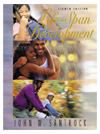 |  Life-Span Development, 8/e John W. Santrock,
University of Texas - Dallas
The Life-Span Development Perspective Introduction
Chapter ObjectivesI.Explain the importance of studying life-span development. |
 |  |  | II.Describe the history of interest in children and adolescents and indicate how contemporary concerns have arisen from previous views. |
 |  |  | III.Describe the seven basic characteristics of the life-span perspective. |
 |  |  | IV.List and describe the three interacting systems of contextualism. |
 |  |  | V.Describe the role that experts in developmental psychology have regarding health and well-being, parenting and education, sociocultural contexts, and social policy. |
 |  |  | VI.Define and distinguish between biological processes, cognitive processes, and socioemotional processes. |
 |  |  | VII.Understand the major developmental periods from conception to death. |
 |  |  | VIII.Define and distinguish between chronological age, biological age, psychological age, and social age. |
 |  |  | IX.Understand the three major developmental issues (nature and nurture, continuity and discontinuity, stability and change). |
 |  |  | X.Identify several options that are available to individuals who are interested in careers in life-span development. |
|



 2002 McGraw-Hill Higher Education
2002 McGraw-Hill Higher Education